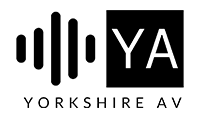High fidelity (often shortened to hi-fi or hifi) is a term used by listeners, audiophiles and home audio enthusiasts to refer to high-quality reproduction of sound.
There are many different components that make up a HiFi system - the most common elements we'll cover in this page.
With all things HiFi and Home Cinema - certain topics on the benefits of one component over another, one brand vs another etc can cause great debate. The only real way is to try and sample the products prior to purchase.
We're fortunate to have our living space converted into a "home showroom" but we have a 75sq m barn in the process of being converted. So should you want to demo some of the below or come to get more information - please don't hesitate to contact us!
The info below is to give you some insight into the terminology used - we'll add to this page with examples of the racks we have on demo.
Source components
A HiFi source is exactly that - the source of the music / sound.
Sources can sometimes be integrated into other components i.e. it is quite common to see a network streamer and CD player with a DAC built into them. Make sure you don't duplicate your sources and do ensure that your amplifiers have enough inputs to connect all of your sources!
Example of sources are:
- Network streamers e.g. audiolab 6000N network streamer or the Bluesound Node 2i
- CD players / CD transport
- Record players / turntables
- USB stick
- Digital Audio Converter (DAC) e.g. connecting a laptop to a DAC to stream local music over
- FM/DAB radio
- Bluetooth / 3.5mm audio jack

Amplifiers
There are a couple of different amplifiers that we come across in HiFi. Those are:
- Power Amplifiers - these take a source input via balanced cable or RCA and provide a high output power to stereo (2) speakers. Power amplifiers are used when you have a smaller amplifier / pre-amplifier that takes a source but has not enough (if any) drive for a bigger set of speakers. They're also used heavily in home cinema where "AV receivers" have limited output power and need the dedicated power amplifiers to take the input and amplify it to the speakers. e.g. audiolab 8300XP power amplifier provides a massive 2 x 140W per channel at 8 ohms!
- Integrated Amplifiers - these are a pre-amplifier and a stereo amplifier in one. i.e. you can connect your sources to the integrated amplifier as well as your speakers. This is the most common amplifier that is found in many HiFi racks. Most integrated amplifiers provide a power output between 50W per channel and 100W per channel.
- Mono Block Amplifiers - a mono block / mono amp is used where you want to have an independent amplifier per speaker i.e. a left mono and a right mono. Mono power amps have only one channel of amplification inside so they're usually lighter, smaller, and easier to carry than multichannel amps. Storage is easier with mono block amps as well.
- Pre Amplifier - as the name would suggest, preamplifier (preamp or "pre") is an electronic amplifier that converts a weak electrical signal (input) into an output signal strong enough to be noise-tolerant and strong enough for further processing, or for sending to a power amplifier or less commonly, an integrated amplifier and then a loudspeaker. Pre-Amplifiers are less common day to day but certain setups feature a dedicated Pre-Amp which can usually connect many many inputs (e.g. RCA, phono, optical, coax, wifi) and then onto a power amplifier.

Turntables
A turntable / record player deserves it's own section.
Yes, it's a source as we've mentioned above - but there are many different types of turntables as well as many varying components that can all be interchanged / improved over time in line with a listeners preference and budget!
Some elements are:
- automatic turntables - you press "play" on these and the tonearm moves across and lowers itself and resets itself at the end of a record. Less common these days.
- manual turntables - you are in control of the speed (33rpm or 45rpm), you set the tonearm and you lower the cartridge to the record. At the end of an album, you move the tonearm back
- tonearm – A pivoting metal arm that supports the cartridge and allows it to hang over the record and track the record groove as it spins toward the center of the record.
- cartridge - the cartridge containing your stylus is what generates an electrical signal from the tracking of a records grooves. The cartridge is precision mounted and aligned to the headshell so it can accurately track record grooves while the tonearm is moving during record spinning. There are two common cartridge types - MM (common = moving magnet) and MC (less common = moving coil). Both have their benefits - MM are more available, cheaper and will last a long time in comparison to the MC which require fine tuning and wear out quicker. The benefit of the latter however, is the quality of the audio signal is significantly greater (generally - like for like) on the MC units.
- platter - the surface where you place your record and is spun by the belt in order for the stylus/needle to track the record groove. Can sometimes be vinyl or cork mats on top of the platter.
- RCA outputs - analog audio connection port allowing you to wire your turntable to your speakers or amplifier. Usually, a grounding screw is found here which is connected to your amplifier/pre-amplifier. This removes any humming/buzzing from the signal by grounding the unit.
Some turntables feature an integrated pre-amplifier (i.e. you can connect headphones or the unit directly to an amplifier/integrated amplifier).
The majority feature just RCA ports which require a connection to a pre-amplifier.
Most integrated amplifiers feature a MM phono stage/pre-amplifier in them but the quality may be limited.
A dedicated phono stage (phono pre-amplifier) is designed to take the signal from your turntable, clean it and amplify it ready for a direct connection to a amplifier.

Speakers / output
Obviously speakers need to be mentioned - the majority of systems are being listened to on speakers. Floorstanding speakers (i.e. full height) have a larger cabinet and usually a lower frequency (bass) response than standmount / bookshelf speakers (smaller cabinet design - found in more discrete/smaller systems).
More common now are in-wall and in-ceiling speakers as well as dedicated on-wall speakers.
Speakers are generally matched in terms of RMS (root mean square) power to the output of your amplifier.
e.g. a speaker whose power range is 50-150W RMS could be driven by a 50W per channel amplifier but the result may be less pleasing than say an integrated amplifier pushing 100W or a power amp pushing 150W.
Similarly, speakers that are 25-50W being played by an amp with 150W will likely end up in a pop/bang if one were to get carried away.
Speaker components:
- Most speakers have 2 posts / input terminals - The positive terminal (+) is typically red, while the negative terminal (-) is typically black. Some higher end speakers feature 4 posts / input terminals. Two terminals for both high and low frequency - these are used generally where amplifiers have a high and low frequency speaker output (and is called bi-wiring or if you have an amplifier per channel - bi-amping).
- Generally speaking - the higher end speakers (i.e. those over £1000) are quite sensitive. As such - any poor quality signals (low quality amp, low quality source, poor quality cables) end up sounding terrible with flat spots or noise being amplified through the speakers themselves.
- Bass reflex port speakers uses a port (hole) or vent cut into the cabinet and a section of tubing or pipe affixed to the port. This port enables the sound from the rear side of the diaphragm to increase the efficiency of the system at low frequencies as compared to a typical sealed- or closed-box loudspeaker or an infinite baffle mounting. Ports can be rear facing or front facing - but there are other speakers out there with bottom or top facing too!
Important to note - a rear facing port needs to positioned forward of the wall else the soundwaves will be compressed / amplified locally and the room will end up with standing waves / poor atmosphere. If your speakers need to be positioned next to a wall - consider on-wall or front firing ports.
- High frequency driver - a driver in a speaker cabinet dedicated to producing high frequencies. Also known as a “tweeter.”
- Low frequency driver - a driver in a speaker cabinet dedicated to producing low frequencies. Also known as a “woofer.”

Example Racks

Q Acoustics Concept 300 stand mount speakers
Pro-Ject Audio Debut Carbon Evo turntable
Pro-Ject Audio Tube Box DS2 phono pre-amplifier
Pro-Ject Audio Stream Box DS2 T network streamer

